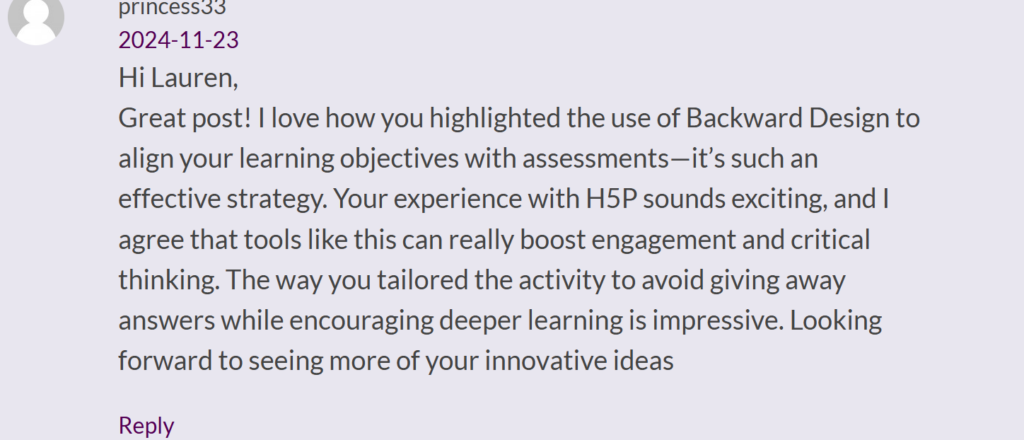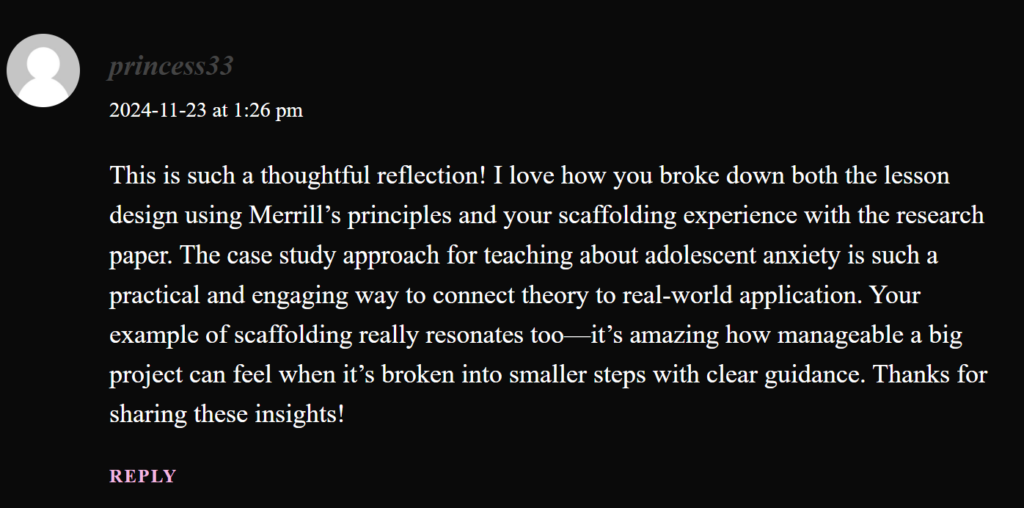Multimedia Learning with H5P
Lesson Planning: Teaching Disability Rights to College Students
| Big Idea | Learning Outcome(s) | Evidence of Learning | Assessments | Learning Activities |
| At the end of this lesson, learners (college students) will understand disability rights as fundamental human rights and that creating inclusive environments requires actively challenging discrimination, understanding the historical and legal context of disability rights, and promoting accessibility in all aspects of society. This knowledge empowers students to advocate for equity and inclusiveness, not only within the college setting but throughout their personal and professional lives. | By the end of this lesson, students will be able to: 1. Identify Key Disability Rights Legislation 2. Analyze Historical and Social Context 3. Recognize and Address Ableism 4. Advocate for Accessibility and Inclusion 5. Reflect on Personal and Societal Attitudes | Evidence for learning in this topic would be measured by the student’s ability to: 1. Demonstrate Knowledge of Disability Rights Legislation 2. Engage in Thoughtful Analysis 3. Identify and Address Ableism in Context 4. Propose Practical Accessibility Solutions 5. Reflect on Personal Growth | Learners will be assessed in the following ways: 1. Quiz at the end of this topic. 2. Group Presentation on Accessibility Solutions 3. Class Discussion Participation 4. Reflective Journals 5. Analysis of real-world scenarios | Learning Activities: 1. Class discussion which encourages students to share initial thoughts on the topic 2. Brief lecture which will include a short video/documentary highlighting personal stories 3. Small breakout groups to analyze different case studies and answer a list of questions. 4. Personal reflection by students on what they learned, mentioning what they previously thought about the topic, how their knowledge has evolved and how they would apply it in their daily lives. |
Reflection: What authentic problem would you use to design a lesson using Merrill’s principles? What media or multimedia (interactive or not) would you create to support it?
To design a lesson using Merrill’s principles, consider the authentic problem: “How can students reduce waste in their school to promote environmental sustainability?”
Engage with a Real-World Problem:
- Introduce students to the environmental impact of waste in schools and challenge them to design a plan to reduce it.
- Show an introductory video that highlights waste management issues in schools and the environmental consequences. The video could include interviews with local environmental experts or showcase successful school waste reduction programs.
Activate Prior Knowledge:
- Facilitate a brainstorming session where students share their own experiences or prior knowledge about recycling, waste reduction, and environmental impact.
- Use an infographic that explains key terms like recycling, composting, and waste hierarchy. This can serve as a reference throughout the lesson.
Demonstrate New Knowledge:
- Provide students with interactive simulations or case studies about waste reduction efforts in other schools. Through branching scenarios, students could make decisions in a simulated environment to see the outcomes of their choices on waste reduction.
- Create an interactive video or case study that allows students to explore different waste management practices, such as recycling bins, compost programs, and reusable materials, and see the impact of each choice on a virtual school’s waste output.
Apply New Knowledge:
- In groups, students create their own waste reduction plans for the school. They can present their ideas using digital tools to design posters, presentations, or infographics explaining their strategies.
- Provide templates for presentations or infographic creation tools like Canva, where students can visualize their waste reduction strategies.
Integrate Knowledge into Their World:
- Students implement part of their waste reduction plan or raise awareness in the school community about waste reduction.
- Students can document their initiatives using a blog or video series, creating a record of their project and sharing their outcomes with peers and the school community. This could be done on a platform like WordPress, incorporating images, infographics, or video clips.
Media or Multimedia to Support
Introductory Video: Shows the problem’s significance and provides real-world contexts.
Infographic: Defines key concepts related to waste management.
Interactive Video/Case Study: Simulates waste management decisions, allowing students to experience the consequence.
Presentation/Infographic Templates: Supports students in visualizing and presenting their waste reduction plans.
Blog or Video Documentation Platform: Enables students to share their project and reflect on their learning, promoting integration and community impact.
References
FLVRFITT. “FUN AFROBEATS WORKOUT: AMAPIANO EDITION | 30 MIN.” YouTube, uploaded by FLVRFITT, 1 year ago, https://www.youtube.com/watch?v=JPcTeQXhIow.
My comment on classmate posts for module 3.



One response to “Module 3”
Thank you for offering your thoughts! Your lesson plan effectively integrates multimedia elements and by using videos, case studies, and interactive group activities, you’ve provided multiple avenues for students to engage deeply with the topic. The use of diverse assessments, including quizzes, discussions, and reflective journals, provides a well-rounded approach to evaluating student learning. This framework not only increases understanding of disability rights but also equips students to advocate for inclusivity in their communities.